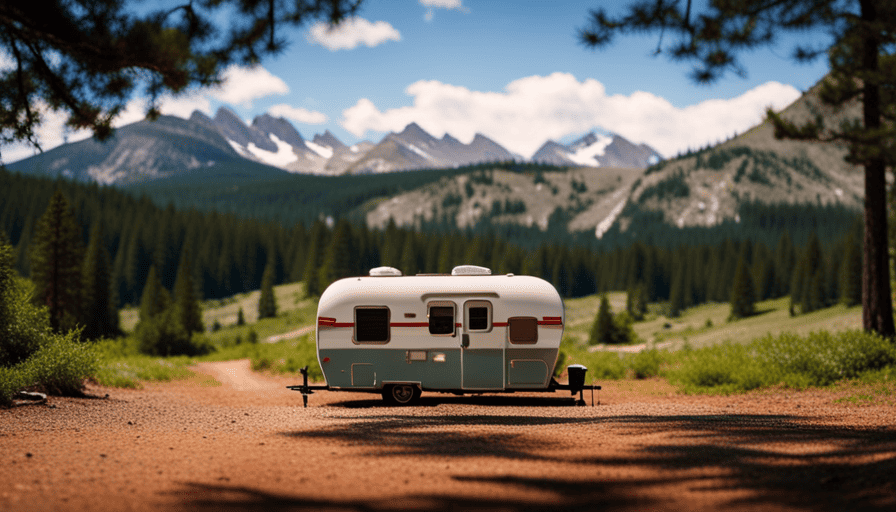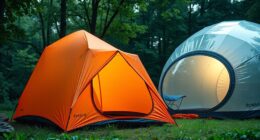Starting my latest camping adventure, I was brimming with excitement and anticipation. The sense of freedom on the open road, the expansiveness of the great outdoors, and the chance to explore new places were all within reach.
However, as I started walking around my camper, a disconcerting sensation shook me to my core. Quite literally. It was as if the very foundations of my home away from home were trembling beneath my feet. Intrigued and slightly concerned, I embarked on a quest to uncover the mystery behind the camper shakes.
In this article, I will delve into the physics behind this phenomenon and explore the possible causes. From examining weight distribution and tightening suspension components to considering upgrades and anti-sway devices, I will provide you with a comprehensive guide to address this issue.
So, join me on this journey as we unravel the secrets of the camper shakes and find solutions to ensure a smooth and enjoyable camping experience.
Key Takeaways
- Shaking in a camper can be caused by factors such as weight distribution, suspension components, upgrades, and anti-sway devices.
- The camper’s suspension system is designed to absorb and dampen vibrations, but factors such as frequency, amplitude, resonance, springs, shocks, road conditions, weight distribution, and tire pressure can contribute to shaking.
- Tips for improving stability include checking weight distribution, using leveling blocks or ramps, inspecting and tightening shock absorbers and connections, upgrading the suspension system, and using stabilizing jacks or leveling blocks.
- Other methods to improve stability include using anti-sway devices, aerodynamic modifications, proper loading techniques, and paying attention to the camper’s weight capacity. Seeking professional advice is recommended if shaking persists.
Understanding the Physics Behind Camper Shakes
When you walk, your camper shakes as if it’s being rocked by an invisible force. This phenomenon can be explained by the physics of vibrations and the design of camper suspension systems.
Vibrations are oscillations that occur when an object moves back and forth or up and down. When you take a step, your weight is transferred to the camper, causing it to vibrate. These vibrations travel through the suspension system, which is designed to absorb and dampen them. However, sometimes the suspension system may not be able to effectively handle the vibrations, leading to increased shaking.
The physics behind these vibrations can be complex, involving factors such as frequency, amplitude, and resonance. Frequency refers to the number of vibrations per second, while amplitude measures the size of the vibrations. Resonance occurs when the frequency of the vibrations matches the natural frequency of the camper, causing it to shake more intensely.
Identifying the possible causes of camper shakes requires a thorough examination of the suspension system, including the springs, shocks, and other components. Additionally, factors such as road conditions, weight distribution, and tire pressure can also contribute to the shaking.
By understanding the physics behind camper shakes and investigating the various factors involved, we can find effective solutions to minimize this unwanted movement.
Identify Possible Causes of Camper Shakes
As you stroll along, you may notice a slight tremor in your stride. This phenomenon, known as camper shakes, can be attributed to the physics of vibrations and the effects of road conditions. There are several possible causes for camper shakes, and it’s important to identify them in order to find a solution.
-
Uneven weight distribution: Unequal distribution of weight inside the camper can lead to imbalanced forces, causing the vehicle to shake. This can be due to improper packing or overloading of one side.
-
Tires and suspension: Worn-out tires or a faulty suspension system can also contribute to camper shakes. When the tires aren’t properly inflated or aligned, or when the suspension is worn out, it can result in vibrations that are transmitted to the camper.
-
Road conditions: The quality of the road surface plays a significant role in camper shakes. Uneven or bumpy roads can cause the tires to bounce, leading to vibrations and shaking.
Understanding the physics of vibrations and considering the effects of road conditions are crucial when trying to identify the causes of camper shakes. By examining these factors, you can determine whether the issue lies with weight distribution, tires and suspension, or road conditions. This knowledge will help you address the problem effectively in the subsequent section about checking for uneven weight distribution.
Check for Uneven Weight Distribution
Easily evaluate if your load is lopsided to eliminate the likelihood of lingering lurches. Uneven weight distribution is a common cause of camper shakes when walking. When the weight inside the camper is not distributed evenly, it can cause instability and vibrations while on the move.
To check for uneven weight distribution, start by ensuring that heavy items are evenly distributed throughout the camper. This can be done by rearranging the items or adding extra weight to the lighter side. Additionally, consider using leveling blocks or ramps to ensure that the camper is sitting evenly on its tires. This will help distribute the weight evenly and reduce the chances of shakes.
If you still experience shaking after adjusting the weight distribution, there are other potential solutions to consider, such as inspecting and tightening suspension components. By addressing the issue of uneven weight distribution, you can minimize the chances of your camper shaking while walking.
Inspect and Tighten Suspension Components
To ensure a smooth and stable ride, it’s important to inspect and tighten the suspension components of your vehicle. The physics of vibrations can greatly affect the performance of your camper, and signs of suspension wear shouldn’t be ignored.
Here are three key areas to focus on when inspecting and tightening your suspension components:
-
Check the condition of the shock absorbers. Look for signs of leaking fluid or excessive movement. Worn or damaged shock absorbers can result in a bumpy and unstable ride.
-
Inspect the bushings and mounts. These components help absorb and dampen vibrations. If they’re worn or loose, they can contribute to the shaking and instability of your camper.
-
Tighten all bolts and connections. Over time, vibrations can cause nuts and bolts to loosen. Ensuring that all connections are tight and secure will help minimize any unwanted movement.
By addressing these areas and making any necessary repairs or adjustments, you can improve the overall stability and performance of your camper. Consider upgrading your camper’s suspension system for an even smoother and more comfortable ride.
Consider Upgrading Your Camper’s Suspension System
Upgrade your camper’s suspension system to enhance its stability and ensure a smoother and more comfortable ride. Upgrading the suspension is a crucial step in reducing camper shakes and improving overall performance. By investing in a higher-quality suspension system, you can minimize the impact of bumps and vibrations, providing a more enjoyable camping experience.
When considering an upgrade, opt for suspension components that are specifically designed for your camper’s weight and size. This will ensure optimal performance and prevent any potential issues that may arise from mismatched parts. Upgrading your suspension system can also provide increased ground clearance, allowing you to navigate rough terrains with ease.
There are various options available for upgrading your camper’s suspension system. One popular choice is installing heavy-duty shock absorbers, which help absorb the impact of uneven surfaces and reduce the transfer of vibrations to the camper. Additionally, upgrading to stiffer springs can improve stability and prevent excessive swaying while driving.
Incorporating sway bars into your suspension system can also significantly enhance stability. These bars work by minimizing the side-to-side movement of your camper, reducing the risk of tipping and improving overall control.
Considering an upgrade to your camper’s suspension system is an excellent way to reduce camper shakes and enhance your camping experience. By investing in the right components, you can achieve improved stability, smoother rides, and increased comfort.
In the next section, we’ll explore the use of stabilizing jacks or leveling blocks to further enhance the stability of your camper.
Use Stabilizing Jacks or Leveling Blocks
Improve the stability of your camper by using stabilizing jacks or leveling blocks. These provide a secure foundation for a worry-free camping experience. When your camper shakes while walking, it’s usually due to an uneven surface or unbalanced weight distribution. Stabilizing jacks and leveling blocks offer a simple yet effective solution to this problem. Here are three reasons why you should consider using them:
-
Stability: Stabilizing jacks are designed to support and stabilize your camper, preventing it from rocking or swaying. By extending these jacks to the ground, you create a solid and level base, minimizing movement inside your camper while walking.
-
Ease of Use: Stabilizing jacks and leveling blocks are user-friendly and can be easily installed and adjusted. Most stabilizing jacks come with a crank handle or an electric motor, allowing you to effortlessly raise or lower them to the desired height.
-
Versatility: Whether you’re camping on a sloped terrain or an uneven surface, leveling blocks can help you achieve a stable camper setup. These blocks can be stacked or arranged in different configurations to accommodate your specific needs, ensuring a level camper and a comfortable camping experience.
By using stabilizing jacks or leveling blocks, you can significantly reduce shaking and discomfort while walking inside your camper. However, if you’re looking for additional measures to enhance stability, you may consider investing in anti-sway devices.
Invest in Anti-Sway Devices
Enhance your camping experience with the added stability and peace of mind provided by investing in anti-sway devices. These devices are designed to minimize the side-to-side motion of your camper, ensuring a smoother and more comfortable journey. By reducing the sway, you can enjoy a safer and more enjoyable camping trip.
One of the main benefits of using anti-sway devices is improved stability. These devices work by counteracting the forces that cause your camper to shake when walking. They distribute the weight more evenly, preventing excessive movement and keeping your camper steady on the road.
In addition to providing stability, anti-sway devices offer an alternative to traditional stabilization methods. While stabilizing jacks and leveling blocks are effective for reducing up-and-down motion, they do little to address side-to-side movement. By investing in anti-sway devices, you can complement these traditional methods and achieve a more balanced and secure camping experience.
To give you an overview of some popular anti-sway devices available on the market, consider the following table:
| Device Name | Features | Benefits |
|---|---|---|
| Sway control bars | Attaches to the trailer frame and hitch | Reduces sway and improves handling |
| Weight distribution hitch | Distributes tongue weight more evenly | Enhances stability and control |
| Sway control system | Utilizes both friction and tension to reduce sway | Provides a smoother and safer ride |
| Electronic sway control | Uses sensors and actuators to counteract sway | Offers precise and automatic sway reduction |
Investing in anti-sway devices not only enhances the stability of your camper, but also provides a safer and more comfortable camping experience. By reducing the sway, you can minimize the risk of accidents and damage to your camper. In the next section, we will explore how you can further improve your camper’s performance by reducing wind resistance with aerodynamic modifications.
Reduce Wind Resistance with Aerodynamic Modifications
After investing in anti-sway devices to minimize the camper’s shaking, it’s time to focus on reducing wind resistance with aerodynamic modifications. By making these changes, we can not only increase fuel efficiency but also improve handling and stability while on the road.
To achieve these goals, there are several modifications that can be made. Firstly, installing an air deflector at the front of the camper can redirect airflow, reducing drag and turbulence.
Secondly, adding side skirts along the camper’s sides can help streamline the airflow and minimize wind resistance.
Lastly, incorporating a rear spoiler can further optimize aerodynamics, allowing for smoother airflow detachment.
These aerodynamic modifications are crucial in reducing the impact of wind on the camper, which in turn, helps to enhance fuel efficiency and overall performance. By minimizing wind resistance, the camper will experience less swaying and instability, resulting in a smoother and more enjoyable journey.
As we move forward, it’s important to delve into another crucial aspect of camper stability: practicing proper loading techniques. This will ensure that the weight is distributed evenly and safely, further enhancing the camper’s stability and handling.
Practice Proper Loading Techniques
To optimize the stability and handling of your vehicle, it’s crucial to focus on practicing proper loading techniques.
By understanding and implementing these techniques, you can prevent camper shakes and ensure a smoother and safer journey.
First and foremost, it’s important to distribute the weight evenly throughout your camper. This means placing heavier items closer to the floor and towards the front and center of the vehicle. This will help maintain a balanced load, reducing the chances of your camper shaking when walking.
Additionally, securing your belongings properly is key. Utilize straps, bungee cords, or nets to secure loose items and prevent them from shifting during transit. This will not only reduce wind resistance but also minimize the movement inside the camper, reducing the likelihood of shakes.
Furthermore, pay attention to the camper’s weight capacity. Overloading your vehicle can lead to excessive vibrations and instability. Consult your camper’s manual or seek guidance from the manufacturer to determine the maximum weight it can safely carry.
By practicing proper loading techniques, you can significantly reduce the chances of experiencing camper shakes. However, if shaking persists despite your efforts, it’s advisable to seek professional advice. A qualified technician will be able to assess the situation and provide recommendations to further enhance the stability and handling of your camper.
Seek Professional Advice if Shaking Persists
Moving on to the current subtopic, it’s important to know when to seek professional advice if the shaking of your camper persists. While practicing proper loading techniques is crucial in minimizing shaking, sometimes the issue may require the expertise of a professional.
If you have followed all the recommended loading guidelines and your camper still shakes when walking, it’s time to consider seeking professional assistance. Professional advice should be sought when the shaking persists despite your efforts to resolve the issue. They can help identify any underlying problems that may be causing the shaking and provide potential solutions.
These solutions may include reinforcing the camper’s structure, adjusting the suspension system, or addressing any imbalances in weight distribution. When seeking professional advice, it’s important to choose a reputable service provider with experience in camper repairs. They’ll have the knowledge and expertise to diagnose the problem accurately and provide appropriate solutions.
If your camper continues to shake when walking despite practicing proper loading techniques, it’s advisable to seek professional advice. They can assess the situation, identify potential causes, and offer suitable solutions to ensure a stable and comfortable camping experience. Remember, the safety and stability of your camper should always be a priority when enjoying your outdoor adventures.
Here are some key areas to consider when addressing shaking issues:
- Proper weight distribution: Ensure that the weight inside the camper is evenly distributed to minimize shaking.
- Suspension system: Consider upgrading or adjusting the suspension system to enhance stability.
- Structural reinforcement: Reinforce weak areas of the camper’s structure to reduce shaking.
- Tire pressure: Check and maintain the proper tire pressure to ensure optimal performance and stability.
Frequently Asked Questions
How can I determine if my camper’s suspension system needs upgrading?
To determine if my camper’s suspension system needs upgrading, I would first conduct a thorough inspection. I would look for signs of wear and tear, such as leaking shocks or worn-out bushings. Additionally, I would pay attention to any unusual noises or vibrations while driving. It’s also important to consider the weight capacity and load distribution of the camper. Regular suspension maintenance, including checking and adjusting tire pressure, can help optimize performance and prevent excessive shaking.
What are some common signs of uneven weight distribution in a camper?
Common causes of uneven weight distribution in a camper can be attributed to improper loading, unbalanced cargo, or a malfunctioning suspension system. To troubleshoot this issue, start by checking the weight distribution of your camper and ensuring that heavy items are properly positioned over the axles.
Additionally, inspect the suspension system for any signs of damage or wear. If necessary, consider upgrading your suspension system to ensure a smoother and more stable ride.
Are there any specific aerodynamic modifications that can help reduce camper shaking?
There are indeed specific aerodynamic modifications that can greatly reduce camper shaking. By implementing these modifications, you can experience a remarkable decrease in the unsettling movements that plague many campers.
From sleek, streamlined designs to strategically placed spoilers and air deflectors, these enhancements work together to minimize air turbulence and improve overall stability. With the right aerodynamic modifications, you can enjoy a smoother, more comfortable ride, ensuring your camper stays steady and secure on the road.
What are some examples of anti-sway devices that can be used to stabilize a camper?
Examples of stability devices that can be used to stabilize a camper include sway control bars, weight distribution hitches, and electronic sway control systems.
Sway control bars attach to the trailer hitch and the frame of the camper, providing increased stability by reducing side-to-side movement.
Weight distribution hitches redistribute the weight evenly between the camper and the towing vehicle, improving stability and reducing swaying.
Electronic sway control systems use sensors and brakes to automatically correct any swaying motion, ensuring a safer towing experience.
How can I practice proper loading techniques in order to prevent camper shaking?
To ensure camper stability, it’s crucial to practice proper loading techniques. This involves distributing weight evenly throughout the camper and securing items to prevent shifting during travel.
Start by positioning heavy items low and towards the center of the camper to maintain balance. Utilize tie-downs, load bars, and anti-sway devices to further enhance stability.
Following these loading techniques will minimize the risk of camper shaking and ensure a smooth and safe journey.
Can Camping on BLM Land Cause Shaking in My Camper When Walking?
Camping rules on blm land vary based on location and individual management plans. While it is unlikely for camping alone to cause shaking in your camper when walking, there may be other external factors like wind, terrain conditions, or nearby activities that can contribute to vibrations. It is always advisable to choose a level campsite and ensure your camper is properly stabilized to minimize any potential movement.
Conclusion
So there you have it, folks! After delving into the physics of camper shakes and exploring the various causes and solutions, I hope you feel more equipped to tackle this issue head-on.
Remember, it’s crucial to check for uneven weight distribution and inspect suspension components before considering upgrades or anti-sway devices.
Don’t forget to reduce wind resistance with aerodynamic modifications and practice proper loading techniques.
And if all else fails, don’t hesitate to seek professional advice.
Now, go forth and enjoy your smooth, shake-free camping adventures!











